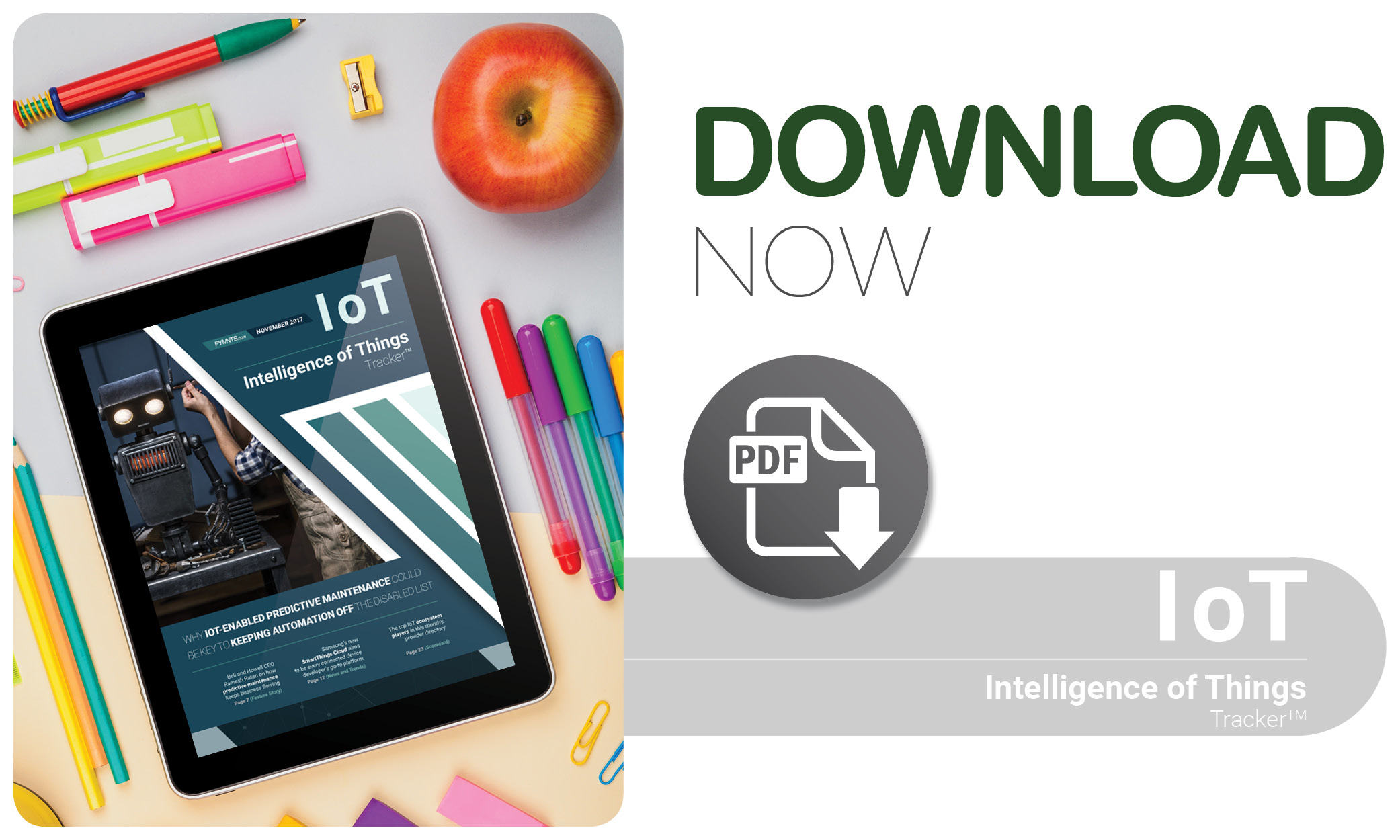Why IoT-Enabled Predictive Maintenance Could Be Key To Keeping Automation Off The Disabled List
If it ain’t broke — then use IoT to fix it before it breaks. In November’s Intelligence of Things (IoT) Tracker™, Bell and Howell CEO Ramesh Ratan and VP Don Bullock explain why companies are rushing to embrace IoT to fix machines before they break to keep their businesses running 24/7. Find that, plus headlines on the first 5G-ready antenna, Amazon’s in-home delivery, automated adaptive automobile security and more from around the IoT space — including a scorecard of 239 industry players — all inside the Tracker.
Imagine this: You find the perfect gift online and snap it up with a few clicks. Next, you get the notice it’s arrived at a nearby self-serve smart locker that can quickly dispense the package. You’ve got just enough time before work to swing by and pick it up. The person in front of you scans her receipt code, the machine pops out a package, then you’re up. The machine starts whirring … and then grinds to a halt. So do your plans.
That scenario, and others like it, are the speedbumps CEO of equipment service provider Bell and Howell Ramesh Ratan is determined to make sure don’t crop up.
In today’s world of business automation, keeping machines running seamlessly is critical to keeping commerce flowing and customers served, Ratan says. In fact, the need is so great that eradicating such malfunctions has become part of the latest shape of his company’s evolving business focus.
Once solely hardware manufacturer, Ratan’s company is now increasingly turning its spotlight on providing installation, maintenance, management and workflow services on equipment from other manufacturers.
According to Ratan and his vice president of technical and professional services, Don Bullock, it’s not enough to wait for equipment to break to fix it. Instead, the team is turning to IoT to create newer, faster ways to catch and stop equipment failure before it happens, thus minimizing machine downtime.
Predictive maintenance
Traditionally, equipment installation and maintenance firms send repair technicians to the rescue when things fail, and perhaps every several months for regular equipment checks — both of which can entail taking machines offline. But, bring connected sensors and machine learning into the mix, and these companies can anticipate in advance when and which component fails, or is on the brink of failing, and proactively dispatch a technician. That technician will arrive on-site, with the proper parts, ready to nip the problem in the bud.
That’s a valuable service to Ratan’s clients, who range from a robotics company seeking to ensure its automated room service robots don’t break down in the midst of ferrying a drink to a guest’s hotel room, to hospitals that need their various scanners to monitor patients without interruption or else, well, someone could actually die. Another client manufacturers an automated package-dispensing smart locker, which Ratan says can trim consumers’ buy-online-pick-up-in-store time from waiting for 45 minutes as a store clerk rummages in the storage room, to 15 seconds as the machine pops out the package — so long as nothing breaks, of course.
And, if something does break, as Bullock noted, it’s a real pain for consumers.
“If you go into one of these retailers and your package is in the machine and the machine is broken, now you’re going to have to come back another time,” he said.
For many large retailers and businesses leaning heavily on such automation, that automation needs to operate day and night, 365 days a year — or as near to it as possible, Ratan said.
To make sure this happens, Bell and Howell turns to in-machine sensors that securely hook into the internet and can be used to monitor conditions. They run predictive analytics and machine learning operations on gathered data to estimate when components will fail, based on similar data from other machines. All that means a big drop in unexpected equipment downtimes and less time locking up a machine in preventative maintenance checks.
To get business clients on board with IoT, Ratan said, he sells them on the vision of increased productivity.
“We sell the value proposition of ‘always on,’ [or] the ability to dramatically reduce costs,” he said. “[They want] the ability to have predictive analytics.”
As companies seem set to increasingly use automation in place of human labor for repetitive tasks, it is critical to ensure the machines are monitored continuously for safety, efficiency, repair and maintenance purposes, according to Ratan.
“As you go to automation, you need this kind of network workflow monitoring technology to make sure you maintain that kind of [higher] productivity,” he explained.
Now, Bullock and Ratan are hoping to boost this monitoring and make things look even rosier in consumers’ eyes. Bell and Howell recently partnered with PTC and is using its ThingWorx platform to support remote diagnosis of mechatronic machines.
“The beauty of the PTC-ThingWorx platform is it’s going to give us the ability to know beforehand when the machine is going to fail,” Bullock said, “and we can proactively go in at a time that is convenient to our customer and replace components and do maintenance and know that the machine is going to have very high reliability.”
No device left behind
As it turns out, older devices don’t have to be left out in the pre-IoT cold. Under its partnership with PTC, Bullock says his firm can now retrofit and smarten machines that were built before the emergence of connectivity.
Technicians can install a package of environmental sensors capable of detecting aspects such as temperature, vibration, humidity and light on any machine. If the sensors can talk to a server via a network — a local wireless network, for example — they can be used to monitor the machine’s conditions. This, in turn, allows for predictions for when an environmental fluctuation could cause parts to malfunction, for instance in a printer, where sensors can detect when humidity might get to the point to cause paper to curl and parts to jam.
If doing away with printer jams doesn’t get your adrenaline pumping, consider this other potential use: Old car lovers could bring their adored autos into the IoT age. Ratan suggested a vehicle like the Ford model A-1 could be outfitted with sensors and actuators to link up the car to a network, allowing it to be equipped OnStar and other capabilities for which the vehicle was never designed.
Growing intelligence, not costs
It’s not just the B2B clients who run more efficiently with IoT-enabled equipment, it’s the machine equipment maintenance company itself. For Ratan, implementing this IoT enables his company to give more rapid client response and deploy employees more efficiently. As a result, the firm can expand its client base and earnings without having to proportionally expand the number of employees on payroll.
In the end, IoT is all about getting machines to work well with people and augment their abilities, Ratan says. IoT is not just a network of things, but an interconnection of machines, sensors, actuators and people.
“Everyone talks about ‘Internet of Things’ of components talking to each other or machines talking to each other,” Ratan said. “We like to call it internet of people and things … As we look at the future, it’s all about our ability to mix what’s traditionally been a people business with a network of things and a technology business.”
. . . . . . . . . . . . . . . .
To download the latest edition of the PYMNTS.com Intelligence of Things Tracker™, click the button below.
The PYMNTS.com Intelligence of Things Tracker™ showcases companies that are leading the way in all aspects of the Intelligence of Things. Every month, the Tracker examines what these companies are doing across the ecosystem and in several categories, including Personal, Home, Retail, Transportation, Wearable, Mobile, Infrastructure, Data and more.

